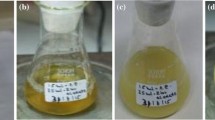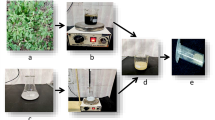Abstract
The present work describes the bio-based green synthesis and characterization of zinc oxide nanoparticles (ZnO NPs) using leaf extract of Tridax procumbens; the synthesized nanoparticles were used to study their beneficial effect on the growth and metabolism of Vigna radiata. ZnO NPs were characterized using X-ray diffraction (XRD), Fourier transform infrared (FTIR) spectroscopy, high-resolution transmission electron microscopy (HR-TEM), and ultraviolet–visible spectroscopy (UV–Vis spectra). Growth of V. radiata seedlings was measured in terms of shoot length and root length that were treated 20 and 40 mg/L concentrations of green synthesized ZnO NPs and constant concentration (50 mg/L) of PbCl2. These studies have shown the effect of ZnO NPs in the stimulation of growth as well as physiological and biochemical parameters. Vigna seedlings showed positive effects depending upon the increasing concentrations of ZnO NPs. This study suggests that ZnO NPs can be effectively used to ameliorate the toxicity of Pb in Vigna plants.











Similar content being viewed by others
Data Availability
Not applicable.
References
Singh, R. P., Shukla, V. K., Yadav, R. S., Sharma, P. K., Singh, P. K., & Pandey, A. C. (2011). Biological approach of zinc oxide nanoparticles formation and its characterization. Advanced Materials Letter, 2, 313–317.
Bala, N., Saha, S., Chakraborty, M., Maiti, M., Das, S., Basub, R., & Nandy, P. (2015). Green synthesis of zinc oxide nanoparticles using Hibiscus subdariffa leaf extract: Effect of temperature on synthesis, anti-bacterial activity and anti-diabetic activity. RSC Advances, 5, 4993–5003.
Hussain, I., Singh, N. B., Singh, A., Singh, H., & Singh, S. C. (2016). Green synthesis of nanoparticles and its potential application. Biotechnology Letters, 38, 545–560.
Lin, D., & Xing, B. (2008). Root uptake and phytotoxicity of ZnO nanoparticles. Environmental Science and Technology, 42, 5580–5585.
Singh, N. B., Amist, N., Yadav, K., Singh, D., Pandey, J. K., & Singh, S. C. (2013). Zinc oxide nanoparticles as fertilizer for the germination, growth and metabolism of vegetable crops. Journal of Nanoengineering and Nanomanufacturing, 3, 1–12.
Nas, F. S., & Ali, M. (2018). The effect of lead on plants in terms of growing and biochemical parameters: A review. MOJ Ecology & Environmental Science, 3, 265–268.
Elemike, E. E., Uzoh, I. M., Onwudiwe, D. C., & Babalola, O. O. (2019). The role of nanotechnology in the fortification of plant nutrients and improvement of crop production. Applied Sciences, 9, 499.
Abdul-Baki, A. A., & Anderson, J. D. (1973). Relationship between decarboxylation of glutamic acid and vigor in soybean seed. Crop Science, 13, 227–232.
Lichtenthaler, H. K. (1987). Chlorophylls and carotenoids: Pigments of photosynthetic biomembranes. Methods in Enzymology, 148, 350–382.
Hedge, J. E., Hofreiter, B. T., & Whistler, R. L. (1962). Carbohydrate chemistry (p. 17). Academic Press.
Beyer, W. F., & Fridovich, I. (1987). Assaying for superoxide dismutase activity some large consequences of minor changes in conditions. Analytical Biochemistry, 161, 559–566.
Cakmak, I., & Marschner, H. (1992). Magnesium deficiency and high light intensity enhance activities of superoxide dismutase, ascorbate peroxidase, and glutathione reductase in bean leaves. Plant Physiology, 98, 1222–1227.
Jaworski, E. G. (1971). Nitrate reductase assay in intact plant tissues. Biochemical and Biophysical Research Communications, 43, 1274–1279.
Lutts, S., Kinect, J. M., & Bouharmont, J. (1996). NaCl-induced senescence in leaves of rice (Oryza sativa L.) cultivars differing in salinity resistance. Annals of Botany, 78, 389–398.
Heath, R. L., & Packer, L. (1968). Photo peroxidation in isolated chloroplasts: I. Kinetics and stoichiometry of fatty acid peroxidation. Archives of Biochemistry and Biophysics, 125, 189–198.
Bates, L. S., Walderen, R. D., & Taere, I. D. (1973). Rapid determination of free proline for water stress studies. Plant and Soil, 39, 205–207.
Jain, N., Bhargava, A., Tarafdar, J. C., Singh, S. K., & Panwar, J. (2013). A biomimetic approach towards synthesis of zinc oxide nanoparticles. Applied Microbiology and Biotechnology, 97, 859–869.
Jayaseelan, C., Rahuman, A. A., Kirthi, A. V., Marimuthu, S., Santhoshkumar, T., Bagavan, A., Gaurav, K., Karthik, L., & Rao, K. B. (2012). Novel microbial route to synthesize ZnO nanoparticles using Aeromonashydrophila and their activity against pathogenic bacteria and fungi. SpectrochimicaActa Part A: Molecular and Biomolecular Spectroscopy, 90, 78–84.
Prashanth, G. K., Prashanth, P. A., & Nagabhushana, B. M. (2018). Comparison of anticancer activity of biocompatible ZnO nanoparticles prepared by solution combustion synthesis using aqueous leaf extracts of Abutilon indicum, Meliaazedarach and Indigoferatinctoria as biofuels. Artificial Cells, Nanomedicine, and Biotechnology, 46, 968–979.
Sangeetha, G., Rajeshwari, S., & Venckatesh, R. (2011). Green synthesis of zinc oxide nanoparticles by Aloe barbadensis Miller leaf extract: Structure and optical properties. Materials Research Bulletin, 46, 2560–2566.
Saha, R., Subramani, K., Raju, S. A. K. P. M., Rangaraj, S., & Venkatachalam, R. (2018). Psidium guajava leaf extract-mediated synthesis of ZnO nanoparticles under different processing parameters for hydrophobic and antibacterial finishing over cotton fabrics. Progress in Organic Coatings, 124, 80–91.
Luque, P. A., Nava, O., Soto-Robles, C. A., Vilchis-Nestor, A. R., Garrafa-Galvez, H. E., & Castro-Beltran, A. (2018). Effects of Daucus carota extract used in green synthesis of zinc oxide nanoparticles. Journal of Materials Science: Materials in Electronics, 29, 17638–17643.
Ngoepe, N. M., Mbita, Z., Mathipa, M., Mketo, N., Ntsendwana, B., & Hintsho-Mbita, N. C. (2018). Biogenic synthesis of ZnO nanoparticles using Monsonia burkeana for use in photocatalytic, antibacterial and anticancer applications. Ceramics International, 44, 16999–17006.
Rajeshkumar, S., Kumar, S. V., Ramaiah, A., Agarwal, H., Lakshmi, T., & Roopan, S. M. (2018). Biosynthesis of zinc oxide nanoparticles using Mangifera indica leaves and evaluation of their antioxidant and cytotoxic properties in lung cancer (A549) cells. Enzyme and Microbial Technology, 117, 91–95.
Raliya, R., Nair, R., Chavalmane, S., Wang, W. N., & Biswas, P. (2015). Mechanistic evaluation of translocation and physiological impact of titanium dioxide and zinc oxide nanoparticles on the tomato (Solanum lycopersicum L.) plant. Metallomics, 7(12), 1584–1594
Liu, J., Cai, H., Mei, C., & Wang, M. (2015). Effects of nano-silicon and common silicon on lead uptake and translocation in two rice cultivars. Frontiers of Environmental Science & Engineering, 9(5), 905–911.
Venkatachalam, P., Jayaraj, M., Manikandan, R., Geetha, N., Rene, E. R., Sharma, N. C., & Sahi, S. V. (2017). Zinc oxide nanoparticles (ZnONPs) alleviate heavy metal-induced toxicity in Leucaena leucocephala seedlings: A physiochemical analysis. Plant Physiology and Biochemistry, 110, 59–69.
Tripathi, D. K., Singh, V. P., Prasad, S. M., Chauhan, D. K., & Dubey, N. K. (2015). Silicon nanoparticles (SiNp) alleviate chromium (VI) phytotoxicity in Pisum sativum (L.) seedlings. Plant Physiology and Biochemistry, 96, 189–198.
Ali, S., Rizwan, M., Noureen, S., Anwar, S., Ali, B., Naveed, M.,& Ahmad, P. (2019). Combined use of biochar and zinc oxide nanoparticle foliar spray improved the plant growth and decreased the cadmium accumulation in rice (Oryza sativa L.) plant. Environmental Science and Pollution Research, 26 (11) 11288–11299
Mahajan, P., Dhoke, S. K., & Khanna, A. S. (2011). Effect of nano-ZnO particle suspension on growth of mung (Vigna radiata) and gram (Cicer arietinum) seedlings using plant agar method. Journal of Nanotechnology, 2011, 1-7.
Funding
The authors wish to acknowledge University Grant Commission, New Delhi, India (Ref. No. 20/12/2015 (ii) EU-V; Sr. No. 2121530863, dated: 14.07.2016), for providing financial assistance under Junior Research Fellowship (NET-UGC-JRF) Scheme.
Author information
Authors and Affiliations
Contributions
Ravi Kumar Yadav contributed in experiment designing and performing, writing, and drawing the figures of this manuscript. VijayaYadav, Shubhra Khare Niharika, and Zeba Azim formatted the content of the article. Ajey Singh and N. B. Singh critically evaluated and reviewed the manuscript.
Corresponding author
Ethics declarations
Ethical Approval
Not applicable.
Consent to Participate
Not applicable.
Consent to Publish
All authors have approved the manuscript and agree with its submission to Applied Biochemistry and Biotechnology.
Competing Interests
The authors declare no competing interests.
Additional information
Publisher's Note
Springer Nature remains neutral with regard to jurisdictional claims in published maps and institutional affiliations.
Supplementary Information
Below is the link to the electronic supplementary material.
Rights and permissions
About this article
Cite this article
Yadav, R.K., Singh, N.B., Singh, A. et al. Role of Bio-Based Synthesized Nanozinc Oxide in Ameliorating the Deleterious Effects Caused by Lead in Vigna radiata L. Appl Biochem Biotechnol 194, 2005–2020 (2022). https://doi.org/10.1007/s12010-022-03801-2
Accepted:
Published:
Issue Date:
DOI: https://doi.org/10.1007/s12010-022-03801-2




